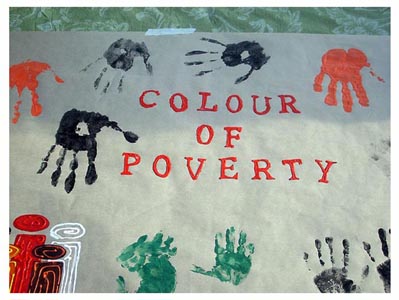To mark the “International Day for the Eradication of Poverty,” members of the Colour of Poverty Campaign — Colour of Change Network (COP/C) from various parts of Ontario — held a press conference earlier this month to call on all levels of Canadian government to help eradicate poverty in Ontario and Canada.
The group has many concerns about the “invisibility of racialized poverty” and the lack of attention to these issues in the media in Toronto and GTA’s upcoming municipal elections.
Poverty should not be shunted to the side and yet it has been, time and time again, when elections come around. In the case of local and municipal politics, there is a sense that these are the politicians who have the knowledge and the power to do something about it. They are also mandated to do so, far more than federal or provincial members of parliament. As poverty has become more and more racialized in the past 10 years in Canada, and as communities of colour become a larger portion of the populations in cities such as Toronto, Windsor, Brampton, and Mississauga, the gap between the majority white elected officials and the needs of their constituencies grows ever wider.
Report card
Earlier this month, the Colour of Poverty released a “report card” that gave Rob Ford, the front-runner in the mayoral race for Toronto, an F for his position on the following issues that are part of the Colour of Poverty’s platform: expansion of affordable housing, the extension of voting rights to non-citizens, support for employment equity programs, and access to city programs and services for racial minorities.
Rob Ford declined to meet with the group, and he has also subsequently declined to attend other community events such as a mayoral debate at the 519 Community Centre, the main centre for LGBTTIQQ2S activities and events in Toronto.
This is not leadership.
Racism and poverty
The Colour of Poverty does a challenging job: they point to the realities of how poverty in Toronto is getting more and more racialized, that is, the numbers of people in poverty are more and more populated by communities of colour, without reiterating any racist tropes about poor folks of colour. They look instead to systemic measures and government responsibilities that have failed, time and time again, in the City of Toronto and elsewhere in Ontario, to deal effectively with why poverty continues to occur, and why poverty and racism are increasingly affecting more people and families in Toronto and Ontario.
Racism is endemic across Canada, in both individual ways, as well as systemic and institutional ways. The Colour of Poverty campaign looks to eradicate poverty through the following points:
• Build community capacity
Truly a ground-up and grassroots movement, the Colour of Poverty sees the work of eradicating poverty, racism and other systemic injustices as being rooted in the communities themselves that are affected by such oppressions on a daily basis.
• Develop a shared framework for action
Since oppression is greatly influenced, and delivered, through various provincial mechanisms, having a shared understanding of what the goal is has become very important. This means no more discussion of “multiculturalism” and “diversity” and more talk of communities, oppression, resistance and social justice for all.
• Make change happen: moving forward on implementation
Action, of course, is what’s needs, not more studies or commissions that don’t speak to or address the real issues. The Colour of Poverty is proposing that “multi-sectoral dialogue” happens through ongoing cross-sectoral working groups. This will enable the changing needs of various communities to be known, and an ongoing dialogue means that there will always be a communication mechanism. But action is key.
Toronto’s municipal election 2010
So, which candidates for city councilors and which candidates for mayor support these ideals?
In the upcoming municipal election, Toronto needs solid, progressive leadership. We need a mayor and city councilors who understand what poverty looks like downtown, in north-west Etobicoke, in Scarborough, in Lawrence Heights, in Jane-Finch. We need leaders who will act, not blame, and who will provide good, thoughtful and reflective solutions. We need leaders who will have active, realistic, community-based measures to support and continue the work already being done by various grassroots organizations throughout the city. We need people in positions of power and influence to understand all the areas that connect to poverty, racism and other oppressions, which includes the list of Fact Sheets that the Colour of Poverty put together in 2007: education, health, meaningful employment, income, the justice system, immigration, affordable housing in neighbourhoods all over Toronto/GTA, and food security.
The expertise is in place; what we need are good, open politicians who will use such opportunities and facilitate and further an era of city-positivity, where marginalized voices are heard front and centre, and where active systemic barriers are taken down and eradicated. Poverty being one such barrier.
Being mayor of Canada’s largest urban centre isn’t a contest to be won. Poverty and racism aren’t games. Being mayor of Toronto is a job that needs someone who will address all members of the city, not just those who are either rich/well-off or reflect dinosaurian values from yester-century.
We tried that. Remember Mel Lastman? It didn’t work.
To be crystal clear, neither Rob Ford nor George Smitherman reflects this view of Toronto. Only Joe Pantalone does, and that’s why he has my vote and my support.
May Lui is a long-time anti-oppression activist and educator, Toronto resident, writer, and moderator of babble, the progressive discussion board on rabble.ca




